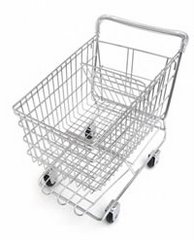
One of the key design issues surrounding this idea is concerned with how the user will navigate around the virtual world. It has been decided to use a physical device in the shape of a shopping trolley handle as an interface to the virtual world. However, it is important to discuss the nature of how the customer will actually view the products.
One of the most influential factors we considered during brainstorming was to beware of information overload, a problem that many elderly shoppers have to overcome.
 The picture above is a bad example of the type of layout we want the supermarket to have, with lots of crowded products which would be hard to browse. One feature in this example that certainly would be found in our virtual world is the information boards above the aisles. These are found in every supermarket, and allow for more familiarity and ease of browsing.
The picture above is a bad example of the type of layout we want the supermarket to have, with lots of crowded products which would be hard to browse. One feature in this example that certainly would be found in our virtual world is the information boards above the aisles. These are found in every supermarket, and allow for more familiarity and ease of browsing. The that most likely way that our customers will browse the shelves will be to have very basic groups shown when viewed from any mid to long distance. For example if the pushed the trolley left to look at the shelf they would see a view similar to the picture below:
 In this example, the products are far too dense and unclear. In our supermarket, the more the user turns the trolley towards the shelf, the more detailed the products will become. From a distance a whole section of products could be shown by a single picture, I.e. a tin of baked beans. When zoomed fully in to the beans section, the user could then browse all the individual products. Selecting these products could bring up an information section display nutritional values, allergy advice and RDA recommendations.
In this example, the products are far too dense and unclear. In our supermarket, the more the user turns the trolley towards the shelf, the more detailed the products will become. From a distance a whole section of products could be shown by a single picture, I.e. a tin of baked beans. When zoomed fully in to the beans section, the user could then browse all the individual products. Selecting these products could bring up an information section display nutritional values, allergy advice and RDA recommendations.The key things to bear in mind when designing this section of the project are to avoid overloading the customer with information, and making navigation feel natural whilst still mainting a familiar shopping experience.
All images taken from http://www.cse.cuhk.edu.hk/~hanqiu/task/prevWork/2002/Supermarket/supermarket.wrl (virtual reality world)
